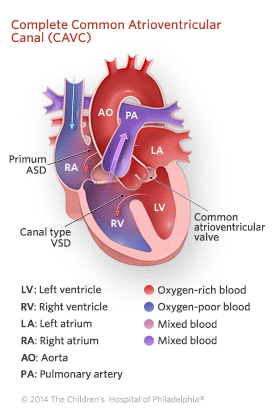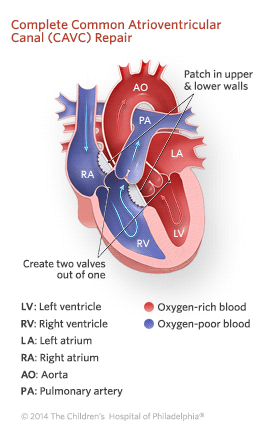What Are The Av Valves
An atrioventricular (AV) culvert defect is a problem in the part of the center that connects the upper chambers (atria) to the lower chambers (ventricles). There are two types of atrioventricular canal defects: complete and fractional.
Complete atrioventricular culvert (CAVC) defect
Complete atrioventricular canal (CAVC) defect is a severe congenital heart affliction in which there is a large hole in the tissue (the septum) that separates the left and right sides of the heart. The hole is in the center of the heart, where the upper chambers where the upper chambers and lower chambers come across.
As the heart formed abnormally, the valves that split up the upper and lower chambers also adult abnormally. In a normal heart, two valves separate the upper and lower chambers of the heart: the tricuspid valve separates the correct chambers and the mitral valve the left. In a kid with a complete atrioventricular canal defect, there is one large valve, and information technology may not close correctly.
As a result of the aberrant passageway betwixt the two sides of the heart, claret from both sides mix, and as well much blood circulates back to the lungs earlier it travels through the body. This means the heart works harder than it should accept to, often becoming enlarged and damaged if the bug aren't repaired.

Fractional atrioventricular canal defects
A fractional atrioventricular canal defect, also known as atrioventricular septal defect (AVSD), is the less astringent form of this center defect. The hole does non extend between the lower chambers of the centre and the valves are better formed. Commonly it is necessary simply to close the hole between the upper chambers (this hole is called an atrial septal defect or ASD) and to do a small-scale repair of the mitral valve. Partial atrioventricular culvert is also chosen atrioventricular septal defect, or AVSD.
In a consummate atrioventricular canal defect, the post-obit symptoms may be present within several days or weeks of nascency:
- Bluish or regal tint to lips, skin and nails (cyanosis)
- Difficulty breathing
- Poor weight gain and growth
- Middle murmur: the centre sounds abnormal when a doctor listens with a stethoscope
Atrioventricular septal defects may cause fewer symptoms than some other heart defects and may not exist diagnosed until the child reaches their 20s or 30s. Then, the immature adult may brainstorm to feel irregular heartbeat (arrhythmia), leaky heart valves or other effects.
Sometimes a complete AV canal defect is diagnosed on a fetal ultrasound and/or echocardiogram. Our Fetal Heart Program tin can prepare a plan for delivery and intendance immediately after birth.
The pediatrician who evaluates your baby in the infirmary might also brand the diagnosis. Or a primary care pediatrician might find a heart murmur and other symptoms and refer your child to the Cardiac Center at Children's Infirmary.
Diagnosis of AV culvert defects may require some or all of these tests:
- Echocardiogram: audio waves are used to create an image of the heart
- Electrocardiogram (ECG): a record of the electrical activity of the heart
- Chest X-ray
- Pulse oximetry: a noninvasive style to monitor the oxygen content of the blood
- Cardiac catheterization: a thin tube is inserted into the heart through a vein and/or avenue in either the leg or through the omphalos ("umbilicus")
- Cardiac MRI: a iii-dimensional epitome shows the heart'southward abnormalities
Complete AV canal defects require surgery, usually inside the showtime 2 or three months of life. The surgeon will close the large pigsty with one or two patches. The patches are stitched into the middle muscle, and as the child grows, the tissue grows over the patches.
The surgeon will also separate the single big valve into two valves and volition reconstruct the valves so they are as shut to normal as possible, depending on the child's heart anatomy.
Partial atrioventricular canal defects also require surgery, whether they are diagnosed in childhood or adulthood. A surgeon will patch or stitch the atrioventricular septal defect closed, then repair the mitral valve or supersede it with an artificial valve or a valve from a donated organ.

After surgery, patients initially recover in the Evelyn and Daniel Thou Tabas Cardiac Intensive Care Unit of measurement (CICU), where they receive effectually-the-clock attention from a team of dedicated cardiac disquisitional intendance medicine specialists and specially trained cardiac nurses. As patients meliorate, they are moved to the Cardiac Care Unit of measurement, and eventually home.
Come across Long-Term Outcomes
Considering of enormous strides in medicine and technology, today most children born with atrioventricular canal defects continue to lead productive lives equally adults. Subsequently surgery, virtually children recover completely and won't demand additional surgery or catheterization procedures.
Through age 18
A child who has had surgical repair of an atrioventricular canal defect will require life-long intendance by a cardiologist.
Our pediatric cardiologists follow patients until they are immature adults, analogous care with the primary care doctor. Patients will need to carefully follow doctors' advice, including staying on any medications prescribed.
Sometimes children with an AV culvert defects experience heart problems later in life, including irregular heartbeat (arrhythmia) and leaky or narrowing valves. Medicine, additional surgery and/or cardiac catheterization may be required.
Into adulthood
At Children's Hospital of Philadelphia (CHOP), our pediatric cardiologists follow patients until they are young adults and coordinate care with chief care physicians. Nosotros can also aid with the transition to an adult cardiologist, who has experience working with adult patients with built center disease.
The Philadelphia Adult Congenital Centre Eye, a joint program of CHOP and Penn Medicine, meets the unique needs of adults who were born with center defects.
What Are The Av Valves,
Source: https://www.chop.edu/conditions-diseases/atrioventricular-canal-defects
Posted by: matterfinge1992.blogspot.com


0 Response to "What Are The Av Valves"
Post a Comment